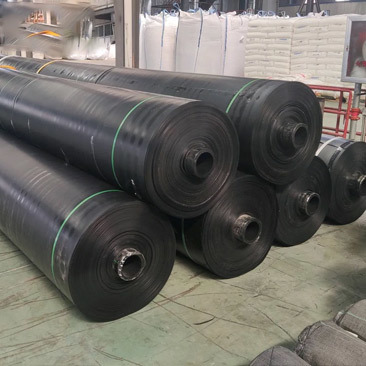Exploring the Benefits of Geomembrane Liners in Construction Projects
Release time:
2025-09-24
Exploring the Benefits of Geomembrane Liners in Construction Projects Table of Contents Introduction to Geomembrane Liners What Are Geomembrane Liners? Benefits of Geomembrane Liners in Construction Environmental Protection Cost Efficiency Durability and Longevity Ease of Installation Applications of Geomembrane Lin
Exploring the Benefits of Geomembrane Liners in Construction Projects
Table of Contents
- Introduction to Geomembrane Liners
- What Are Geomembrane Liners?
- Benefits of Geomembrane Liners in Construction
- Applications of Geomembrane Liners in Construction
- Installation Process of Geomembrane Liners
- Best Practices for Utilizing Geomembrane Liners
- Frequently Asked Questions
- Conclusion
Introduction to Geomembrane Liners
In the ever-evolving construction industry, **geomembrane liners** represent a groundbreaking solution for various applications ranging from waste containment to water management. As environmental concerns rise, the demand for effective and sustainable construction materials increases. This article delves into the **benefits**, **applications**, and **best practices** related to geomembrane liners, demonstrating their indispensable role in modern construction projects.
What Are Geomembrane Liners?
**Geomembrane liners** are impermeable membranes made from synthetic materials, primarily used for containment, separation, or protection in construction projects. Typically manufactured from polyethylene, polypropylene, or polyvinyl chloride (PVC), these liners provide a reliable barrier against liquids and gases. Their versatility and effectiveness make them a preferred choice in various construction scenarios.
Benefits of Geomembrane Liners in Construction
Understanding the myriad advantages of geomembrane liners is crucial for any construction professional. Here, we explore the most significant benefits:
Environmental Protection
One of the primary benefits of geomembrane liners is their role in **environmental protection**. By preventing the escape of contaminants into the soil and groundwater, these liners safeguard ecosystems and human health. They are especially valuable in managing hazardous waste, as they provide an effective barrier against leachate and toxic substances.
Cost Efficiency
In addition to environmental benefits, geomembrane liners also offer **cost efficiency**. Their durability means reduced maintenance and replacement costs over time. Furthermore, by minimizing the risk of contamination and associated legal liabilities, projects utilizing these liners can save significant amounts in potential fines and cleanup efforts.
Durability and Longevity
The **durability** of geomembrane liners is another compelling advantage. Engineered to withstand harsh environmental conditions, including UV radiation, temperature fluctuations, and punctures, these liners have a long lifespan. This resilience ensures that projects do not need frequent replacements, thereby enhancing their **long-term value**.
Ease of Installation
**Ease of installation** is a significant factor contributing to the popularity of geomembrane liners. Lightweight and flexible, these liners can be quickly deployed in various settings. This reduces labor costs and project timelines, enabling construction teams to adhere to tight schedules without compromising quality.
Applications of Geomembrane Liners in Construction
Geomembrane liners find utility across multiple construction applications. Here are some notable examples:
Landfills and Waste Management
In landfills, geomembrane liners serve as a crucial component for **controlling leachate** and preventing groundwater contamination. These liners ensure that hazardous materials are contained, creating a safer environment for surrounding communities.
Water Retention Systems
In **water retention systems**, geomembrane liners are employed to create reservoirs, ponds, and other water storage solutions. Their impermeability ensures that water does not seep into the ground, optimizing the efficiency of water management systems.
Ponds and Reservoirs
Geomembrane liners play a vital role in the construction of ponds and reservoirs, providing a reliable barrier that prevents leakage. This is particularly important in agricultural applications, where water retention is critical for crop irrigation and livestock management.
Installation Process of Geomembrane Liners
The installation of geomembrane liners involves several crucial steps to ensure effectiveness and longevity:
1. **Site Preparation**: Proper site preparation is essential. The ground must be clear of debris, sharp rocks, and vegetation to prevent damage to the liners during installation.
2. **Liner Layout**: After site preparation, the geomembrane material is laid out according to the project specifications. It’s important to ensure that the liner fits the area accurately to avoid overlaps or gaps.
3. **Seaming and Welding**: For larger projects, geomembrane panels are often seamed together. This process typically involves heat welding, where edges of the liner are melted and fused to create a seamless barrier.
4. **Testing**: After installation, the geomembrane liner undergoes testing to ensure there are no leaks or weaknesses. This may include pressure testing or vacuum testing, depending on the application.
5. **Final Inspection**: A thorough final inspection ensures that the installation meets all project specifications and standards.
Best Practices for Utilizing Geomembrane Liners
To maximize the benefits of geomembrane liners, consider the following best practices:
- **Choose the Right Material**: Select the appropriate type of geomembrane material based on your project’s specific requirements, such as temperature, chemical exposure, and expected lifespan.
- **Regular Maintenance**: Even though geomembrane liners are durable, regular inspections and maintenance can prolong their lifespan. Look for signs of wear, punctures, or environmental damage.
- **Proper Training**: Ensure that installation crews are trained in best practices for handling and installing geomembrane liners. This can prevent costly mistakes during installation.
- **Consult Experts**: For large projects, consulting with geomembrane experts can provide valuable insights and recommendations tailored to unique project needs.
Frequently Asked Questions
1. What materials are geomembrane liners made from?
Geomembrane liners are typically made from synthetic materials such as polyethylene, polypropylene, and PVC, providing a reliable barrier against liquids and gases.
2. How long do geomembrane liners last?
The lifespan of geomembrane liners can vary based on material and environmental conditions, but they can last anywhere from 20 to 50 years with proper installation and maintenance.
3. Are geomembrane liners environmentally friendly?
Yes, geomembrane liners are designed to protect the environment by preventing contaminants from leaching into the soil and groundwater.
4. Can geomembrane liners be recycled?
Some geomembrane materials can be recycled, but it is essential to consult with manufacturers regarding specific recycling options and methods.
5. What is the cost of geomembrane liners?
The cost of geomembrane liners can vary widely based on material type, thickness, and project size. It’s advisable to obtain quotes from multiple suppliers for accurate pricing.
Conclusion
In conclusion, geomembrane liners offer a multitude of benefits that make them an indispensable resource in modern construction projects. With their role in environmental protection, cost efficiency, durability, and ease of installation, these innovative materials are transforming how we approach construction challenges. By understanding their applications and best practices, construction professionals can ensure successful project outcomes while contributing to a more sustainable future. Embracing geomembrane liners is not just a smart choice; it is a necessary step toward responsible and effective construction practices.






